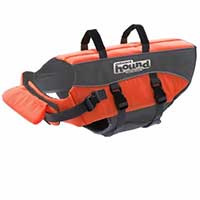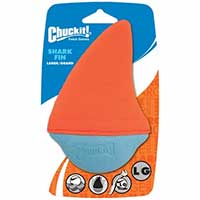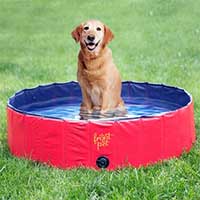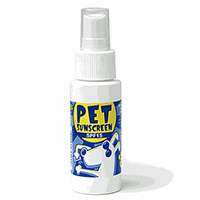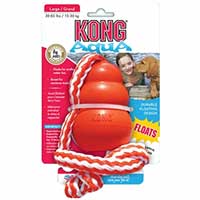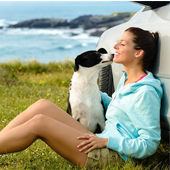One of the best ways to beat the warmer heat is to cool off with a quick swim. Most people understand that pool safety is a serious concern for any swimmer; but for those of us with pets, it's important to ensure that both you and your pet are safe when around the pool. This can mean anything from keeping your pet away from the water to putting them in it- as proper pool safety depends on a wide variety of factors including your petís level of comfort around the water, their age, and even their breed.
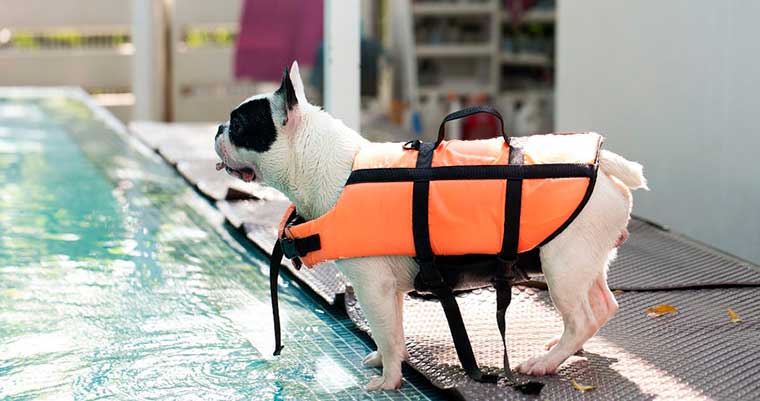
Though both dogs and cats need protection from the danger posed by bodies of water, typically cats tend to avoid the water whereas dogs tend to seek it out. This means that this article will primarily focus on dogs and the way in which you can help your dog feel comfortable in the water; other safety tips, however, will be applicable for households with either pet. In any event, we hope that this guide can help you keep your pets safe and happy throughout the warmer weather swelter.
No Lifeguard on Duty
It's important to remember that any swimmer risks injury when entering the water or even when walking on a particularly wet pool deck. To reduce the possibility of accidents that endanger your pet, it can be helpful to use a barrier to isolate your pool, so that your pets can only enter the water whilst under your supervision.

Depending on the nature of the pool and the surrounding area, this can either mean using a protective pet barrier or completely enclosing the pool area with a fence. If at all possible, responsible pet owners should choose to fence off the entire pool area to prevent accidents from taking place in the pool vicinity as a whole. Clever pets may be able to jump over particularly short gates- so itís also helpful to ensure that any gate you install is an adequate barrier.
Safety While Swimming
Some dogs may be equally averse to the water as cats. While it could be the case that the dog is a breed that's quite naturally not particularly fond of swimming, such as Shih Tzus or Pugs, it could also be the case that they're not entirely comfortable with the water. Dogs that cannot swim are afraid of the water because to them itís a particularly dangerous entity.

Although having a dog that fears the water might appear to simplify pool safety by keeping your pet away from the water, in reality, it puts your pet in serious danger. Pets that cannot swim still face an even greater risk of drowning- as even pets that are afraid of the water may go near it given the right circumstance. A dog chasing a squirrel or attempting to retrieve a ball, for example, may accidentally fall into the pool.
Cats and dogs can both benefit from learning to swim. The capacity to swim can save your petís life- not to mention that it can help keep them healthy. Swimming is the ideal method of exercise for large dogs or arthritic pets that need a method of exercising. Cats and dogs can both benefit from learning to swim. The capacity to swim can save your petís life- not to mention that it can help keep them healthy. Swimming is the ideal method of exercise for large dogs or arthritic pets that need a method of exercising. Teaching your pet to swim can be an arduous process- but it is definitely worth it.
Knowledge is Power
Just as humans rely on lifeguards both to watch over them and to resuscitate them if they become incapacitated, your pets rely on you to ensure that they are safe. This means that it's absolutely imperative that pet owners know how to perform CPR on their cat or dog before allowing them near the pool. As you might expect, the procedure can be quite different from performing CPR on a human, though there are also some important similarities.

One of the most important aspects of using CPR is the knowledge of when to do so. If your dog or cat is incapacitated while in the water- there are a variety of problems to address when rescuing your pet. It's important to understand the difference between artificial respiration, techniques to clear airways, and CPR. If your pet has no pulse- then CPR is the appropriate response; however, if they are merely having difficulty breathing then chest compressions can actually do more harm than good.
Because of the subtleties of emergency response, it's recommended that pet owners sign up for a class to learn CPR from the American Red Cross that also works great with their course in pet first aid. Though this course is offered with the express focus of performing the procedure on humans, it can provide valuable insight into learning the appropriate process for your pet. With this information, it's a relatively simple matter to learn the process specific to your pet from either a veterinarian or other reputable source.
Safety Supplies
There are also a variety of supplies that can make the pool area a much safer place for your pet. In addition to ramps that facilitate entering and exiting the pool and barriers that guard the pool from unsupervised pool play- a life vest can also be a very practical way of keeping your pet safe. Not all pets enjoy wearing life vests, but they offer a comfortable safety precaution for pets learning to swim.

Additionally, itís always a good idea to have a first aid kit ready and available for your dog. Protection for your petís feet can also be essential when it comes to protecting them from the excessively hot pool deck. Lastly, a pair of goggles can help protect your petís eyes from the chlorinated pool water. Even with goggles, however, itís important to ensure that your pool has the appropriate pH balance in addition to the proper level of chlorine. These can be managed with the appropriate pool test kits and supplies.
Did we forget to mention anything? Please let us know if this guide helped you or if you have any questions regarding proper pool safety for your pets by leaving a comment below!

